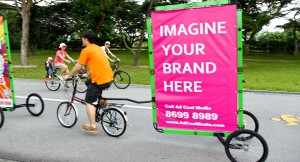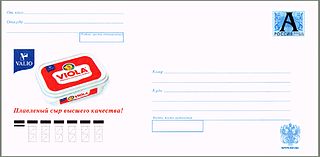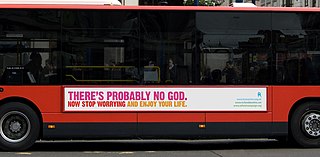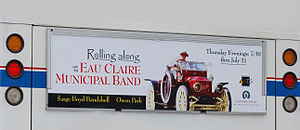
Advertising is the practice and techniques employed to bring attention to a product or service. Advertising aims to put a product or service in the spotlight in hopes of drawing it attention from consumers. It is typically used to promote a specific good or service, but there are wide range of uses, the most common being the commercial advertisement.

A bus is a road vehicle that carries significantly more passengers than an average car or van, but less than the average rail transport. It is most commonly used in public transport, but is also in use for charter purposes, or through private ownership. Although the average bus carries between 30 and 100 passengers, some buses have a capacity of up to 300 passengers. The most common type is the single-deck rigid bus, with double-decker and articulated buses carrying larger loads, and midibuses and minibuses carrying smaller loads. Coaches are used for longer-distance services. Many types of buses, such as city transit buses and inter-city coaches, charge a fare. Other types, such as elementary or secondary school buses or shuttle buses within a post-secondary education campus, are free. In many jurisdictions, bus drivers require a special large vehicle licence above and beyond a regular driving licence.

A television advertisement is a span of television programming produced and paid for by an organization. It conveys a message promoting, and aiming to market, a product, service or idea. Advertisers and marketers may refer to television commercials as TVCs.

Sex appeal in advertising is a common tactic employed to promote products and services. Research indicates that sexually appealing content, including imagery, is often used to shape or alter the consumer's perception of a brand, even if it is not directly related to the product or service being advertised. This approach, known as "sex sells," has become more prevalent among companies, leading to controversies surrounding the use of sexual campaigns in advertising.

A billboard is a large outdoor advertising structure, typically found in high-traffic areas such as alongside busy roads. Billboards present large advertisements to passing pedestrians and drivers. Typically brands use billboards to build their brands or to push for their new products.

A bumper sticker is an adhesive label or sticker designed to be attached to the rear of a car or truck, often on the bumper. They are commonly sized at around 25.4 cm by 7.6 cm and are typically made of PVC.

RoadShow is the first "Multi-Media on-Board" (MMOB) service system on transit vehicles in Hong Kong. It was launched by The Kowloon Motor Bus Holdings Limited in December 2000. The MMOB business was taken over by RoadShow Holdings Limited in 2001 prior to its listing on the Stock Exchange.

Metro is the United Kingdom's highest-circulation freesheet tabloid newspaper. It is published in tabloid format by DMG Media. The newspaper is distributed from Monday to Friday mornings on public places in areas of England, Wales and Scotland. Copies are also handed out to pedestrians.
Out-of-home (OOH) advertising, also called outdoor advertising, outdoor media, and out-of-home media, is advertising experienced outside of the home. This includes billboards, wallscapes, and posters seen while "on the go". It also includes place-based media seen in places such as convenience stores, medical centers, salons, and other brick-and-mortar venues. OOH advertising formats fall into four main categories: billboards, street furniture, transit, and alternative.

JCDecaux Group is a multinational corporation based in Neuilly-sur-Seine, near Paris, France, known for its bus-stop advertising systems, billboards, public bicycle rental systems, and street furniture. It is the largest outdoor advertising corporation in the world.

Wrap advertising or a vehicle wrap is known as the marketing practice of completely or partially covering (wrapping) a vehicle in a vinyl material, which may be for a color change, advertising or custom livery. The result of this process is essentially a mobile billboard. Wrap advertising can be achieved by painting a vehicle's outer surface, but an increasingly ubiquitous practice in the 21st century involves the use of large vinyl sheets as "decals". The vinyl sheets can later be removed with relative ease, drastically reducing the costs associated with changing advertisements. While vehicles with large, flat surfaces are often used, automobiles can also serve as hosts for wrap advertising, despite consisting of more curved surfaces. Wrap advertising is also used in the magazine and publishing industries.

A mobile billboard, also known as a "digital billboard truck", is a device used for advertising on the sides of a truck or trailer that is typically mobile. Mobile billboards are a form of transit media; static billboards, and mall/airport advertising fall into this same category. Using a mobile billboard for advertising is an advertising niche called mobile outdoor advertising.

Alcohol advertising is the promotion of alcoholic beverages by alcohol producers through a variety of media. Along with nicotine advertising, alcohol advertising is one of the most highly regulated forms of marketing. Some or all forms of alcohol advertising are banned in some countries. There have been some important studies about alcohol advertising published, such as J.P. Nelson's in 2000.

Ad creep is the "creep" of advertising into previously ad-free spaces.

The Advertising Standards Authority (ASA) is the self-regulatory organisation of the advertising industry in the United Kingdom. The ASA is a non-statutory organisation and so cannot interpret or enforce legislation. However, its code of advertising practice broadly reflects legislation in many instances. The ASA is not funded by the British government, but by a levy on the advertising industry.

The Atheist Bus Campaign was an advertising campaign in 2008 and 2009 that aimed to place "peaceful and upbeat" messages about atheism on transport media in Britain, in response to evangelical Christian advertising.
Transit media is a form of out-of-home advertising that displays advertisements in or on the outside of vehicles, such as on the side of or above the seats of a bus or tram.

School bus advertising is a form of advertising in the United States in which advertising space is sold on the sides of school buses. School districts typically partner with a marketing firm to sell the space and market the program to businesses, Depending on the size and market of each individual school district, this form of advertising can be very lucrative. Scottsdale Union School District in Arizona expected to make $900,000 in three years, while a smaller school district of 4,100 students in Michigan anticipated $70,000 a year.
Brandalism is an activist artist collective founded in 2012 in the United Kingdom which engages in subvertising, culture jamming, and protest art. Brandalism uses subvertising to alter and critique corporate advertising by creating parodies or spoofs to replace ads in public areas. The art is typically intended to draw attention to political and social issues such as consumerism and the environment. Advertisements produced by the Brandalism movement are silk screen printed artworks, and may take the form of a new image, or a satirical alteration to an existing image, icon or logo. The advertisements are often pasted over billboards, or propped under the glass of roadside advertising spaces.

See-through graphics can be added to glass or other transparent panels to provide advertising, branding, architectural expression, one-way privacy and solar control.

























